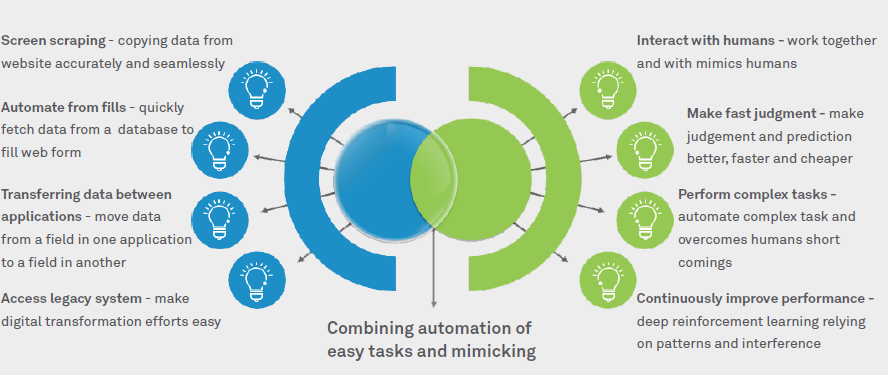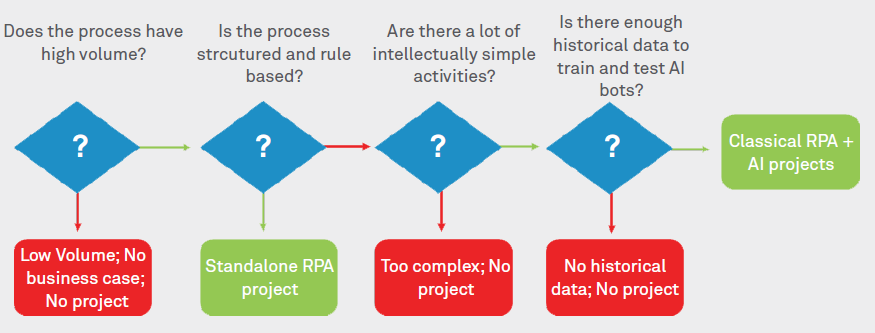Robotic Process Automation and Artificial Intelligence are two indispensable technologies that are great in silos and even greater when combined. Both these technologies have the potential to drive enterprise business transformation. So, if you are thinking of using any of these technologies, you must first understand their individual benefits and the benefits when they are combined together.
The dumb but efficient robots
Let's understand RPA first. RPA refers to the application of preconfigured software that uses business rules to execute processes either autonomously or with human intervention and assistance. Mundane, repetitive and rule-based tasks, which does not require human judgement, can be performed by application of RPA software. Since it is 'User Interface' (UI) based, it does not require expensive technology integrations and, thus, brings about a good ROI, which in turn makes good business justification for its implementation. It also frees up resources to focus on higher value and meaningful activities.
RPA is not a novel concept and has actually been around for many years. However, RPA deployment has not been as much as had been anticipated. This is because in majority of the processes, which are repetitive and rule based, the underlying data is semi-structured or unstructured and RPA bots which are not 'intelligent' but driven solely by business rules could not make use of this data to perform tasks.
The intelligent and self-learning AI robots
The inability of RPA bots has brought AI robots into the picture. What is AI and how does it benefit your organization? Encyclopedia Britannica defines AI as the ability of a digital computer or computer controlled robot to perform tasks commonly associated with intelligent beings. The term is frequently applied to the project of developing systems endowed with the cognitive characteristics of humans, such as the ability to reason, discover meaning, generalize, or learn from experience.
The USP of AI is that AI robots can self-learn over time and apply reason and logic while solving problems. AI also has a subset of technologies, such as Machine Learning (ML), Deep Learning and Neuro-Linguistic Programming (NLP) that can be leveraged to build systems capable of performing cognitive functions that are only within the scope of human intelligence.
Way forward – Marriage of the two robots
So to answer the question that which of these two technologies you should choose for your business - You must have noticed that both of the technologies are capable when applied in silos and can bring about huge benefits to your business. However, the automation applicability and benefits increase exponentially when these technologies are combined.

Figure 1: Combining RPA and AI
For example, those processes where RPA could not be implemented because the underlying data was unstructured and human judgment was involved can now be automated by introducing AI, which would convert the unstructured data to structured data and make decisions as a human would. In addition, AI robots would self-learn over time and thus would further free up resources that are needed to work on the ‘exceptions’, which RPA could not handle. Integrating RPA and AI would also allow the automation process to become significantly faster and end-to-end. Similarly, the lone implementation of AI may not make business sense because of the implementation costs involved, but when combined with RPA, would be viable to implement, as combined ROI of the two technologies would be positive.
Thus, by combining RPA and AI, more and more processes can be automated, customer experience can be improved, business efficiency and productivity can be increased, and the capacity to do other meaningful and value-added tasks can be created. In addition, as RPA is capable of easily integrating to the AI technologies, including machine learning, voice recognition, and natural language processing, and that too at minimal cost, it would makes sense to integrate RPA and AI and take automation to the next level. Many more processes would now be in scope of automation, which would in turn bring greater bottom-line benefits for your organization.
Use case
In an HRO (Human Resource Outsourcing) process for one of our customers, life event details of an employee needed to be entered in an HRO platform and enrollment had to be done. This mundane rule-based task was a typical case for RPA application. However, as benefits related data points from employee's contract documents had to be extracted, it was not possible to deploy RPA alone as the input data from the contractual documents was unstructured and RPA was not able to extract and process the relevant data on its own.
To make it possible for RPA to come into play, our AI solution, Wipro HOLMES™, was introduced. Wipro HOLMES™ leveraged cognitive abilities to extract benefits related data points from the employee's fuzzy contract documents and churned out the data in a structured excel format. RPA Bot was then able to access this structured input received from Wipro HOLMES™ and process the data to do the enrollment automatically without the intervention of a human workforce.
Conclusion
As companies focus on streamlining processes and solving real business problems through technology, the marriage of RPA and AI can offer significant benefits The future would see a plethora of blended RPA and AI solutions being introduced together in business processes.

Figure 2: RPA + AI: Decision Tree
Wipro has already taken a lead in this integration and come up with their in-house RPA tool “Mimictron- Intelligent Process Automation,” which seamlessly homogenizes with the AI technology components of Wipro HOLMES™ like cognitive search, cognitive image processing, deep text extraction, and chat bot. At the same time, we understand that your solution builders have option to use 3rd party RPA platforms and add your other custom services. All these platform and services can be easily stitched to build a single end-to-end solution with Wipro HOLMES™. Wipro HOLMES™ is not just about cost savings but also about the reliability of delivering a service.
Thus, while both RPA and AI would be great for your business when deployed in silos, they can provide even greater benefits when they are deployed together.
References
Preom Dutta
Manager, Digital Operations and Platforms, Enterprise Operations Transformation, Wipro Limited.
Preom is a seasoned digital and automation leader specializing in RPA, machine/deep learning, AI and smart operations pre-sales, solutioning and consulting. He brings to the table both technical acumen and business transformation consulting expertise based on over 14 years of experience in operations, process excellence, continuous improvement and enterprise operation transformation for clients in Europe, US and India. He holds six-sigma Green Belt and Black Belt degrees from ASQ and is a certified Lean facilitator.